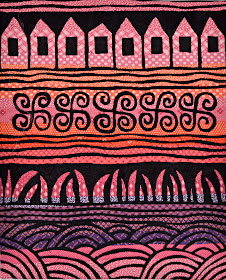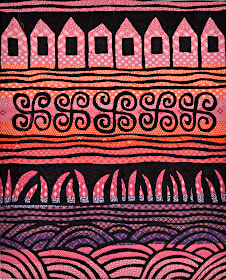Friday, March 30, 2012
South African Drumbeat
When I was at Festival of Quilts in Birmingham, England this past summer, I met Magie Relph, the delightful owner of the African Fabric shop. I bought a basket and a bit of fabric from her, and Magie admired the 12x12 quilts, and before I left I'd agreed to participate in a mini challenge with some of the other Twelves using some South African fabric called "Shweshwe."
The fabric is not what I'd have recognized as African, and when I did a bit of research, I learned why: although it is now made in South Africa, it originated as discharged indigo fabric which was imported from England. A South African textile company eventually started manufacturing the fabric with help from a UK investor. And while it started as primarily indigo and brown fabrics, it's now also made in vibrant oranges, pinks, purples, and reds.
At any rate, that quilt up top is what I did. My inspiration was the patterns from other South African textiles, sort of like this:
I started by cutting a variety of shweshwe prints into strips and piecing them together. They're so pretty, aren't they? I tried organizing them them randomly...
and then I tried doing a light-to-dark arrangement...
and that's what I ended up using, so sewn they looked like this:
Look, even the scraps look pretty in these bright colors:
Then I layered the strip pieced under a layer of black fabric, and onto batting and a backing. I'd drawn my design onto tracing paper, aiming for a loose and primitive use of patterns. I arranged the patterns to create (in my own mind anyway) hills at the bottom, then grass, then flowers, then huts -- a symbolic landscape of sorts. I layered the tissue paper on top of all of the fabric, then sewed through all of those layers with small stitches. (It made a great crinkly sound when wrestling it all under the sewing machine!)
Then, I started peeling the paper away, and cutting away parts of the black fabric to reveal the shweshwe fabric underneath. (Yep, I know -- why did I put the paper on the black layer? I had a reason at the time -- which I can't remember right now but trust me, there was a reason. But after having to pull all those teeny bits of white paper off of the black fabric, I was wishing I'd sewn from the back where the teeny bits wouldn't have shown so much!) And look -- my very sharp Havel scissors go perfectly with the color palette, don't they?
So here's the finished quilt again. It has the sort of hand-drawn, primitive look I wanted.
Here's a detail shot. For some reason I really like those hilly shapes and how the blades of grass look.
You can click on their names to see what Gerrie and Terry did with their shweshwe fabrics!
If you'd like to use some of these beautiful fabrics, they are available through online ordering. In Europe, do try Magie's African Fabric shop. In the US, Magie will ship here ... but if you want to avoid international shipping, a google search will show you where you can order them within the US.












I love this, Diane! Your technique is very intriguing as well.It worked beautifully for this.
ReplyDeleteThis looks wonderful Diane....but it's of no use to click on my name, my ShweShwe fabrics are still uncut, washed and starched but still incut! But aren't they so gorgeous, I bought pinks and purples....
ReplyDeleteBest Wishes
Kay in Scotland
I think you've achieved exactly what you were going for. I like that it references African textiles and imagery, but does not try to BE african. It's very fun and cheerful to look at too. I think Magie and her customers will love it!
ReplyDeleteI would have put the black on top too (working on the theory that it's easier to cut back a single layer of fabric than a piece with seams). The results are very effective. Bravo.
ReplyDeleteGreat technique Diane, I love the design and result.
ReplyDelete